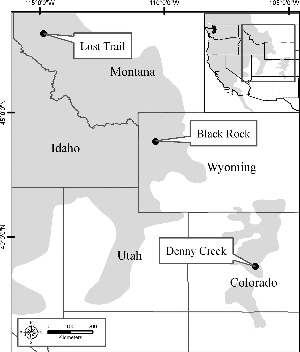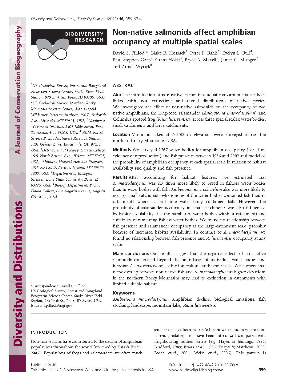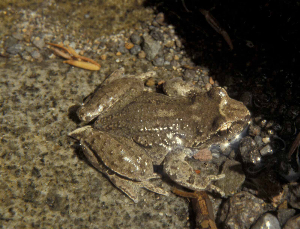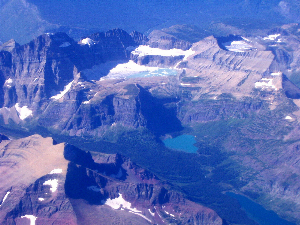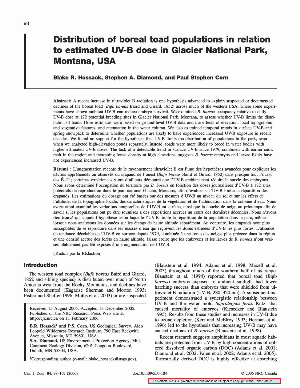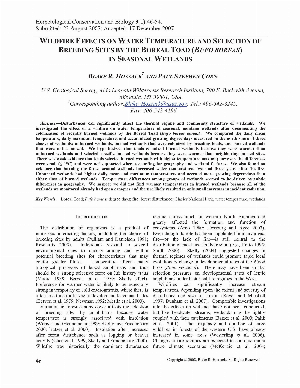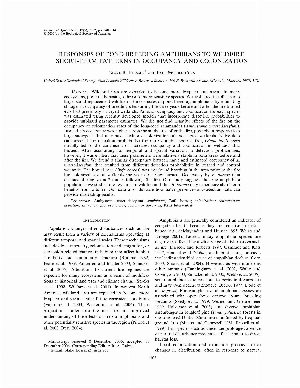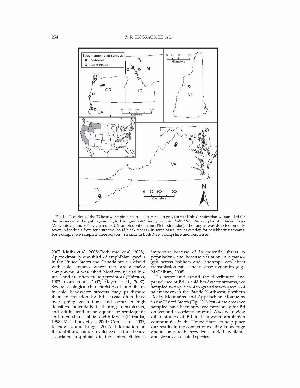Search ARMI Database
Search term(s)
Contribution Number
Search Results
146 record(s) found.
Papers & Reports Disease in a dynamic landscape: Host behavior and wildfire reduce amphibian chytrid infection
Authors: Blake R Hossack; W H Lowe; J L Ware; P. Stephen Corn
Date: 2013 | Outlet: Biological Conservation 157: 293-299
Disturbances are often expected to magnify effects of disease, but these effects may depend on the ecology, behavior, and life history of both hosts and pathogens. In many ecosystems, wildfire is the dominant natural disturbance and thus could directly or indirectly affect dynamics of many diseases. To determine how probability of infection by the aquatic fungus Batrachochytrium dendrobatidis (Bd) varies relative to habitat use by individuals, wildfire, and host characteristics, we sampled 404 boreal toads (Anaxyrus boreas boreas) across Glacier National Park, Montana (USA). Bd causes chytridiomycosis, an emerging infectious disease linked with widespread amphibian declines, including the boreal toad. Probability of infection was similar for females and the combined group of males and juveniles. However, only 9% of terrestrial toads were infected compared to >30% of aquatic toads, and toads captured in recently burned areas were half as likely to be infected as toads in unburned areas. We suspect these large differences in infection reflect habitat choices by individuals that affect pathogen exposure and persistence, especially in burned forests where warm, arid conditions could limit Bd growth. Our results show that natural disturbances such as wildfire and the resulting diverse habitats can influence infection across large landscapes, potentially maintaining local refuges and host behaviors that facilitate evolution of disease resistance.
Papers & Reports Interactive effects of wildfire, forest management, and isolation on amphibian and parasite abundance
Authors: Blake R Hossack; W H Lowe; R K Honeycutt; S A Parks; P. Stephen Corn
Date: 2013 | Outlet: Ecological Applications 23: 479-492
Projected increases in wildfire and other climate-driven disturbances will affect
populations and communities worldwide, including host–parasite relationships. Research in
temperate forests has shown that wildfire can negatively affect amphibians, but this research
has occurred primarily outside of managed landscapes where interactions with human
disturbances could result in additive or synergistic effects. Furthermore, parasites represent a
large component of biodiversity and can affect host fitness and population dynamics, yet they
are rarely included in studies of how vertebrate hosts respond to disturbance. To determine
how wildfire affects amphibians and their parasites, and whether effects differ between
protected and managed landscapes, we compared abundance of two amphibians and two
nematodes relative to wildfire extent and severity around wetlands in neighboring protected
and managed forests (Montana, USA). Population sizes of adult, male long-toed salamanders
(Ambystoma macrodactylum) decreased with increased burn severity, with stronger negative
effects on isolated populations and in managed forests. In contrast, breeding population sizes
of Columbia spotted frogs (Rana luteiventris) increased with burn extent in both protected and
managed protected forests. Path analysis showed that the effects of wildfire on the two species
of nematodes were consistent with differences in their life history and transmission strategies
and the responses of their hosts. Burn severity indirectly reduced abundance of soil-transmitted
Cosmocercoides variabilis through reductions in salamander abundance. Burn severity also
directly reduced C. variabilis abundance, possibly though changes in soil conditions. For the
aquatically transmitted nematode Gyrinicola batrachiensis, the positive effect of burn extent on
density of Columbia spotted frog larvae indirectly increased parasite abundance. Our results
show that effects of wildfire on amphibians depend upon burn extent and severity, isolation,
and prior land use. Through subsequent effects on the parasites, our results also reveal how
changes in disturbance regimes can affect communities across trophic levels.
populations and communities worldwide, including host–parasite relationships. Research in
temperate forests has shown that wildfire can negatively affect amphibians, but this research
has occurred primarily outside of managed landscapes where interactions with human
disturbances could result in additive or synergistic effects. Furthermore, parasites represent a
large component of biodiversity and can affect host fitness and population dynamics, yet they
are rarely included in studies of how vertebrate hosts respond to disturbance. To determine
how wildfire affects amphibians and their parasites, and whether effects differ between
protected and managed landscapes, we compared abundance of two amphibians and two
nematodes relative to wildfire extent and severity around wetlands in neighboring protected
and managed forests (Montana, USA). Population sizes of adult, male long-toed salamanders
(Ambystoma macrodactylum) decreased with increased burn severity, with stronger negative
effects on isolated populations and in managed forests. In contrast, breeding population sizes
of Columbia spotted frogs (Rana luteiventris) increased with burn extent in both protected and
managed protected forests. Path analysis showed that the effects of wildfire on the two species
of nematodes were consistent with differences in their life history and transmission strategies
and the responses of their hosts. Burn severity indirectly reduced abundance of soil-transmitted
Cosmocercoides variabilis through reductions in salamander abundance. Burn severity also
directly reduced C. variabilis abundance, possibly though changes in soil conditions. For the
aquatically transmitted nematode Gyrinicola batrachiensis, the positive effect of burn extent on
density of Columbia spotted frog larvae indirectly increased parasite abundance. Our results
show that effects of wildfire on amphibians depend upon burn extent and severity, isolation,
and prior land use. Through subsequent effects on the parasites, our results also reveal how
changes in disturbance regimes can affect communities across trophic levels.
Papers & Reports Rapid increases and time-lagged declines in amphibian occupancy after wildfire
Authors: Blake R Hossack; W H Lowe; P. Stephen Corn
Date: 2013-02 | Outlet: Conservation Biology 27: 219–228
Climate change is expected to increase the frequency and severity of drought and wildfire. Aquatic and moisture-sensitive species, such as amphibians, may be particularly vulnerable to these modified disturbance regimes because large wildfires often occur during extended droughts and thus may compound environmental threats. However, understanding of the effects of wildfires on amphibians in forests with long fire-return intervals is limited. Numerous stand-replacing wildfires have occurred since 1988 in Glacier National Park (Montana, U.S.A.), where we have conducted long-term monitoring of amphibians. We measured responses of 3 amphibian species to fires of different sizes, severity, and age in a small geographic area with uniform management. We used data from wetlands associated with 6 wildfires that burned between 1988 and 2003 to evaluate whether burn extent and severity and interactions between wildfire and wetland isolation affected the distribution of breeding populations. We measured responses with models that accounted for imperfect detection to estimate occupancy during prefire (0–4 years) and different postfire recovery periods. For the long-toed salamander (Ambystoma macrodactylum) and Columbia spotted frog (Rana luteiventris), occupancy was not affected for 6 years after wildfire. But 7–21 years after wildfire, occupancy for both species decreased ≥25% in areas where >50% of the forest within 500 m of wetlands burned. In contrast, occupancy of the boreal toad (Anaxyrus boreas) tripled in the 3 years after low-elevation forests burned. This increase in occupancy was followed by a gradual decline. Our results show that accounting for magnitude of change and time lags is critical to understanding population dynamics of amphibians after large disturbances. Our results also inform understanding of the potential threat of increases in wildfire frequency or severity to amphibians in the region.
Papers & Reports Estimating occupancy in large landscapes: evaluation of amphibian monitoring in the Greater Yellowstone Ecosystem.
Authors: W R Gould; Debra A Patla; R Daley; P. Stephen Corn; Blake R Hossack; Robert Bennetts; Charles R Peterson
Date: 2012 | Outlet: Wetlands 32:379–389
Monitoring of natural resources is crucial to ecosystem conservation, and yet it can pose many challenges. We developed an amphibian monitoring program as a means for examining ecological conditions in Yellowstone and Grand Teton National Parks. Annual surveys for amphibian breeding occupancy were conducted over a 4-yr period (2006 – 2009) at two scales: catchments (portions of watersheds) and individual wetland sites. Catchments were selected in a stratified random sample with habitat quality and ease of access serving as strata. All known wetland sites with suitable habitat were surveyed within selected catchments. Changes in breeding occurrence of tiger salamanders, boreal chorus frogs and Columbia-spotted frogs were assessed using multi-season occupancy estimation. Numerous a priori models were considered within an information theoretic framework including those with catchment and site-level covariates. Habitat quality was the most important predictor of occupancy. Boreal chorus frogs demonstrated the greatest change (increase) in breeding occupancy at the catchment level. Tiger salamander breeding occurrence increased slightly and Columbia-spotted frogs decreased slightly over the 4-yr period. Larger changes for all 3 species were detected at the finer site-level scale. Use of covariates (e.g., connectivity of sites) offered improvements over simpler models, and may improve understanding of the dynamic processes occurring among wetlands within this ecosystem. Our results suggest monitoring occupancy at two spatial scales within large study areas such as ours is feasible and informative.
Papers & Reports New Collection Records and Range Extension for the caddisfly Arctopora salmon (Smith, 1969) (Trichoptera: Limnephilidae)
Authors: Blake R Hossack; R L Newell; D E Ruiter
Papers & Reports Peptidomic analysis of skin secretions supports separate species status for the tailed frogs, Ascaphus truei and Ascaphus montanus
Authors: J M Conlon; Catherine R Bevier; L Coquet; J Leprince; T Jouenne; H Vaudry; Blake R Hossack
Date: 2007 | Outlet: Comparative Biochemistry and Physiology 2: 121-125
The tailed frog Ascaphus truei Stejneger, 1899 is the most primitive extant anuran and the sister taxon to the clade of all other living frogs. The species occupies two disjunct ranges in the Northwest region of North America: the Cascade Mountains and coastal area from British Columbia to Northern California, and an inland range in the northern Rocky Mountains and the Blue and Wallowa mountains. A previous study led to the isolation of eight peptides with antimicrobial activity termed the ascaphins)from skin secretions of A. truei from the coastal range. The present study has used peptidomic analysis to identify the products of orthologous ascaphin genes in electrically-stimulated skin secretions from inland range specimens. Structural characterization of the peptides demonstrated that ascaphins from the inland range contained the following amino acid substitutions compared with orthologs from the coastal range frogs: ascaphin-1 ((Ala^12->Glu), ascaphin-3 (Asp^4->Glu), ascaphin-4 (Ala^19->Ser), ascaphin-5 (Lys^12->Thr), and ascaphin-7 (Gly^8->Ser and Ser^20->Asn). Orthologs of ascaphins-2, -6, and -8 were not identified but a paralog of ascaphin-5, identical to ascaphin-5 from coastal range frogs, was found. The data support the claims, derived from analysis of the nucleotide sequences of mitochondrial genes, that the inland populations of the tailed frog should be recognized as a distinct species, the Rocky Mountain tailed frog Ascaphus montanus and that the divergence of the species from A. truei probably occurred in the late Miocene (approximately 10 Mya).
Papers & Reports Large, wetland-associated mayflies of Glacier National Park, Montana
Authors: R L Newell; Blake R Hossack
Date: 2009 | Outlet: Western North American Naturalist 69(3): 335-342
We describe species richness and habitat associations of mayflies (Ephemeroptera) collected during amphibian surveys of 355 water bodies in Glacier National Park (NP), Montana, in 2006–2008. We collected 9 taxa (in 7 genera) of mayflies that were identifiable to species. Callibaetis ferrugineus hageni was collected most frequently, followed by Siphlonurus occidentalis, S. phyllis, Ameletus celer, A. similior, Parameletus columbiae, Ephemerella dorothea infrequens, Baetis bicaudatus, and Leptophlebia cupida. Siphlonurus phyllis had not been reported in the western United States prior to our surveys, and P. columbiae is a species of concern in the region. The identifications of 4 additional taxa were uncertain due to the poor condition of specimens found at only one site (Centroptilum sp. and Paraleptophlebia sp.) or because nymphal specimens could not be confidently identified (Cinygma sp. and Cinygmula sp.). Species richness of mayflies in wetlands seems low compared to that in streams and lakes in Glacier National Park. We found the most species of mayflies in beaver ponds, where we detected some species not commonly associated with lentic water bodies. Our survey was the first extensive survey of wetland invertebrates in Glacier NP and only the second that we are aware of in western Montana.
Papers & Reports Branchiopods (Anostraca, Notostraca) from protected areas of western Montana
Authors: Blake R Hossack; R L Newell; C R Rogers
Date: 2010 | Outlet: Northwest Science 84(1): 52-59
Papers & Reports Effects of the amphibian chytrid fungus on toad survival
Authors: David S Pilliod; Erin Muths; R D Scherer; Paul E Bartelt; P. Stephen Corn; Blake R Hossack; Brad A Lambert; Rebecca M McCaffery; C Gaughan
Date: 2010 | Outlet: Conservation Biology 24: 1259-1268
Chytridiomycosis is an amphibian disease linked with population declines worldwide, yet there is little information about its effects on the demography of infected populations. We used capture-recapture data from two infected populations and one uninfected population of boreal toads (Bufo boreas) in the Rocky Mountains, U.S.A. to examine a priori hypotheses about the effect of the amphibian chytrid fungus (Batrachochytrium dendrobatidis, Bd) on survival probability (Φ) and population growth rate (). Bd-positive toads had lower average annual Φ than Bd-negative individuals at sites where Bd was detected suggesting that chytridiomycosis may reduce survival by 31-42% in wild boreal toads. Bd-negative toads at infected sites had comparable survival probabilities as Bd-negative toads at the uninfected site, further supporting observed differences. Model results indicated weak evidence that environmental covariates (particularly cold temperatures during the breeding season) influenced toad survival. The diseased populations were declining by 5 - 7% per year over the 6 years of this study whereas the Bd-free population had comparatively stable ( ≈ 1) population growth. Our data suggest that Bd is a low-level chronic mortality factor in these toad populations rather than an acute factor causing rapid population declines. These results show how some amphibian populations may be coexisting with the amphibian chytrid fungus and highlight the importance of quantitative assessments of survival in wildlife populations challenged with disease.
Papers & Reports Non-native salmonids affect amphibian occupancy at multiple spatial scales
Authors: David S Pilliod; Blake R Hossack; Peter F Bahls; Evelyn L Bull; P. Stephen Corn; G Hokit; B A Maxell; J C Munger; P Murphy; A Wyrick
Date: 2010 | Outlet: Diversity and Distributions 16: 959–974
Aim
The introduction of non-native species into aquatic environments has been linked with local extinctions and altered distributions of native species. We investigated the effect of non-native salmonids on the occupancy of two native amphibians, the long-toed salamander (Ambystoma macrodactylum) and Columbia spotted frog (Rana luteiventris), across three spatial scales: water bodies, small catchments and large catchments.
Location
Mountain lakes at >1500 m elevation were surveyed across the northern Rocky Mountains, USA.
Methods
We surveyed 2267 water bodies for amphibian occupancy (based on evidence of reproduction) and fish presence between 1986 and 2002 and modelled the probability of amphibian occupancy at each spatial scale in relation to habitat availability and quality and fish presence.
Results
After accounting for habitat features, we estimated that A. macrodactylum was 2.3 times more likely to breed in fishless water bodies than in water bodies with fish. Ambystoma macrodactylum also was more likely to occupy small catchments where none of the water bodies contained fish than in catchments where at least one water body contained fish. However, the probability of salamander occupancy in small catchments was also influenced by habitat availability (i.e. the number of water bodies within a catchment) and suitability of remaining fishless water bodies. We found no relationship between fish presence and salamander occupancy at the large-catchment scale, probably because of increased habitat availability. In contrast to A. macrodactylum, we found no relationship between fish presence and R. luteiventris occupancy at any scale.
Main conclusions
Our results suggest that the negative effects of non-native salmonids can extend beyond the boundaries of individual water bodies and increase A. macrodactylum extinction risk at landscape scales. We suspect that niche overlap between non-native fish and A. macrodactylum at higher elevations in the northern Rocky Mountains may lead to extinction in catchments with limited suitable habitat.
The introduction of non-native species into aquatic environments has been linked with local extinctions and altered distributions of native species. We investigated the effect of non-native salmonids on the occupancy of two native amphibians, the long-toed salamander (Ambystoma macrodactylum) and Columbia spotted frog (Rana luteiventris), across three spatial scales: water bodies, small catchments and large catchments.
Location
Mountain lakes at >1500 m elevation were surveyed across the northern Rocky Mountains, USA.
Methods
We surveyed 2267 water bodies for amphibian occupancy (based on evidence of reproduction) and fish presence between 1986 and 2002 and modelled the probability of amphibian occupancy at each spatial scale in relation to habitat availability and quality and fish presence.
Results
After accounting for habitat features, we estimated that A. macrodactylum was 2.3 times more likely to breed in fishless water bodies than in water bodies with fish. Ambystoma macrodactylum also was more likely to occupy small catchments where none of the water bodies contained fish than in catchments where at least one water body contained fish. However, the probability of salamander occupancy in small catchments was also influenced by habitat availability (i.e. the number of water bodies within a catchment) and suitability of remaining fishless water bodies. We found no relationship between fish presence and salamander occupancy at the large-catchment scale, probably because of increased habitat availability. In contrast to A. macrodactylum, we found no relationship between fish presence and R. luteiventris occupancy at any scale.
Main conclusions
Our results suggest that the negative effects of non-native salmonids can extend beyond the boundaries of individual water bodies and increase A. macrodactylum extinction risk at landscape scales. We suspect that niche overlap between non-native fish and A. macrodactylum at higher elevations in the northern Rocky Mountains may lead to extinction in catchments with limited suitable habitat.
Papers & Reports Taxonomic variation in oviposition by tailed frogs (Ascaphus spp.)
Authors: N E Karraker; David S Pilliod; Michael J Adams; Evelyn L Bull; P. Stephen Corn; L V Diller; L A Dupuis; Marc P Hayes; Blake R Hossack; G R Hodgson; E J Hyde; K Lohman; B R Norman; Lisa M Ollivier; Christopher A Pearl
Date: 2006 | Outlet: Northwestern Naturalist 87: 87-97
Tailed frogs (Ascaphus spp.) oviposit in cryptic locations in streams of the Pacific Northwest and Rocky Mountains. This aspect of their life history has restricted our understanding of their reproductive ecology. The recent split of A. montanus in the Rocky Mountains from A. truei was based on molecular differentiation, and comparisons of their ecology are limited. Our objectives were to provide a range-wide summary of information on Ascaphus oviposition,compare some aspects of the reproductive ecology of the 2 species, and examine geographic variation in their reproductive traits. Reproductive ecology of the 2 species differed. Ascaphus truei had smaller clutches, oviposited later in the summer, and had a longer duration of oviposition than A. montanus. A greater number of communal oviposition sites were attributed to A. montanus. These ecological differences support the recent taxonomic revision of Ascaphus and suggest that different management strategies may be necessary for each species where conservation is a priority.
Papers & Reports Lack of significant changes in the herpetofauna of Theodore Roosevelt National Park, North Dakota, since the 1920s
Authors: Blake R Hossack; David S Pilliod; P. Stephen Corn
Date: 2005 | Outlet: American Midland Naturalist 154: 423–432
We surveyed 88 upland wetlands and 12 1-km river sections for amphibians in Theodore Roosevelt National Park, North Dakota, during 2001–2002 to gather baseline data for future monitoring efforts and to evaluate changes in the distribution of species. We compared our results to collections of herpetofauna made during 1920–1922, 1954 and 1978–1979. The boreal chorus frog (Pseudacris maculata) was the most common amphibian in upland wetlands, followed by the tiger salamander (Ambystoma tigrinum), Woodhouse’s toad (Bufo woodhousii), northern leopard frog (Rana pipiens), plains spadefoot (Spea bombifrons) and the Great Plains toad (B. cognatus). Bufo woodhousii was the only species that bred in the river. Our records for reptiles are less complete than for amphibians but no losses from the community are evident. The herpetofauna in Theodore Roosevelt National Park seems unchanged during at least the last half-century and likely since 1920–1922.
Papers & Reports Distribution limits of Batrachochytrium dendrobatidis: a case study in the Rocky Mountains, USA
Authors: Blake R Hossack; Erin Muths; Chauncey W Anderson; Julie A Kirshtein; P. Stephen Corn
Date: 2009 | Outlet: Journal of Wildlife Diseases 45: 1198–1202
Knowledge of the environmental constraints on a pathogen is critical to predicting its dynamics and effects on populations. Batrachochytrium dendrobatidis (Bd), an aquatic fungus that has been linked with widespread amphibian declines, is ubiquitous in the Rocky Mountains. As part of assessing the distribution limits of Bd in our study area, we sampled the water column and sediments for Bd zoospores in 30 high-elevation water bodies that lacked amphibians. All water bodies were in areas where Bd has been documented from neighboring, lower-elevation areas. We targeted areas lacking amphibians because existence of Bd independent of amphibians would have both ecologic and management implications. We did not detect Bd, which supports the hypothesis that it does not live independently of amphibians. However, assuming a detection sensitivity of 59.5% (based on sampling of water where amphibians tested positive for Bd), we only had 95%confidence of detecting Bd if it was in $16% of our sites. Further investigation into potential abiotic reservoirs is needed, but our results provide a strategic step in determining the distributional and environmental limitations of Bd in our study region.
Papers & Reports Thermal characteristics of amphibian microhabitats in a fire-disturbed landscape
Authors: Blake R Hossack; Lisa A Eby; P. Stephen Corn
Date: 2009 | Outlet: Forest Ecology and Management 258: 1414–1421
Disturbance has long been a central issue in amphibian conservation, often regarding negative effects of logging or other forest management activities, but some amphibians seem to prefer disturbed habitats. After documenting increased use of recently burned forests by boreal toads (Bufo boreas), we hypothesized that burned habitats provided improved thermal opportunities in terrestrial habitats. We tested this hypothesis by conducting a radio telemetry study of habitat use (reported previously) and by using physical models that simulated the temperature of adult toads. We deployed 108 physical models in and adjacent to a 1-year old burn using a fully-replicated design with three burn severities (unburned, partial, high severity) and four microhabitats (open surface, under vegetation, under log, in burrow). Model temperatures were compared to a range of preferred temperatures in published studies. We found 70% more observations within the preferred temperature range of B. boreas in forests burned with high severity than in unburned areas. Burned forest was warmer than unburned forest across all microhabitats, but the largest relative difference was in burrows, which averaged 3 8C warmer in high-severity burn areas and remained warmer though the night. More than twice as many observations were within the preferred temperature range in high-severity burrows than in unburned burrows. Areas burned with high severity were still warmer than unburned forest 3 years after the fire. Habitat use of toads during the concurrent radio telemetry studymatched that predicted by the physical models. These results suggest there are fitness-linked benefits to toads using burned habitats, such as increased growth, fertility, and possibly disease resistance. However, increased soil temperatures that result from wildfire may be detrimental to other amphibian species that prefer cooler temperatures and stable environments. More broadly, our data illustrate the use of physical models to measure and interpret changes that amphibians may experience from disturbance, and highlight the need for research linking vital rates such as growth and survival to disturbance.
Papers & Reports Distribution of the boreal toad populations in relation to estimated UV-B dose in Glacier National Park, Montana, USA
Authors: Blake R Hossack; S Diamond; P. Stephen Corn
Date: 2006 | Outlet: Canadian Journal of Zoology 84: 98–107
A recent increase in ultraviolet B radiation is one hypothesis advanced to explain suspected or documented declines of the boreal toad (Bufo boreas Baird and Girard, 1852) across much of the western USA, where some experiments have shown ambient UV-B can reduce embryo survival. We examined B. boreas occupancy relative to daily UV-B dose at 172 potential breeding sites in Glacier National Park, Montana, to assess whether UV-B limits the distribution of toads. Dose estimates were based on ground-level UV-B data and the effects of elevation, local topographic and vegetative features, and attenuation in the water column. We also examined temporal trends in surface UV-B and spring snowpack to determine whether populations are likely to have experienced increased UV-B exposure in recent decades. We found no support for the hypothesis that UV-B limits the distribution of populations in the park, even when we analyzed high-elevation ponds separately. Instead, toads were more likely to breed in water bodies with higher estimated UV-B doses. The lack of a detectable trend in surface UV-B since 1979, combined with earlier snow melt in the region and increasing forest density at high elevations, suggests B. boreas embryos and larvae likely have not experienced increased UV-B.
Papers & Reports Divergent patterns of abundance and age-class structure of headwater stream tadpoles in burned and unburned watersheds
Authors: Blake R Hossack; P. Stephen Corn; D Fagre
Date: 2006 | Outlet: Canadian Journal of Zoology 84: 1482–1488
Wildfire is a potential threat to many species with narrow environmental tolerances, including the Rocky Mountain Tailed Frog (Ascaphus montanus Mittleman and Myers, 1949), which inhabits a region where the frequency and intensity of wildfires is expected to increase. We compared pre- and post-fire counts of tadpoles in 8 streams in northwest Montana to determine the effects of wildfire on A. montanus. All streams were initially sampled in 2001, 2 years before 4 of them burned in a large wildfire, and were resampled during the 2 years following the fire. Counts of tadpoles were similar in the two groups of streams before the fire. After the fire, tadpoles were almost twice as abundant in unburned streams than in burned streams. The fire seemed to have the greatest negative effect on abundance of age-1 tadpoles, which was reflected in greater variation in same-stream age-class structure compared to unburned streams. Despite the apparent effect on tadpoles, we do not suspect the wildfire is an extirpation threat to populations in the streams we sampled. Studies spanning a chronosequence of fires and in other areas are needed to assess effects on A. montanus streams and to determine the severity and persistence of effects on populations.
Papers & Reports Wildland fire and seasonal wetlands: effects on water temperature and selection of breeding sites by the boreal toad (Bufo boreas)
Authors: Blake R Hossack; P. Stephen Corn
Date: 2008 | Outlet: Herpetological Conservation and Biology 3: 46–54
Disturbances can significantly affect the thermal regime and community structure of wetlands. We investigated the effect of a wildfire on water temperature of seasonal, montane wetlands after documenting the colonization of recently burned wetlands by the Boreal Toad (Bufo boreas boreas). We compared the daily mean temperature, daily maximum Temperature, and accumulated growing degree·days measured on the north shore of three classes of wetlands: unburned wetlands, burned wetlands that were colonized by breeding toads, and burned wetlands that were not colonized. We hypothesized that toads colonized burned wetlands because they were warmer than unburned wetlands and selected specific burned wetlands because they were warmer than neighboring burned sites. There was weak evidence that toads selected burned wetlands with higher temperature maxima; however, the differences were small (≤ 1°C) and were not supported when accounting for geography and wetland features. We also found no evidence that burning the forest around wetlands increased water temperatures two and three years after the fire. Unburned wetlands had higher daily mean and maximum temperatures and accrued more growing degree·days than either class of burned wetlands. Temperature differences among groups of wetlands seemed to be driven by subtle differences in geography. We suspect we did not find warmer temperatures in burned wetlands because all of the wetlands we monitored already had open canopies and the fire likely resulted in only small increases in incident radiation.
Papers & Reports Responses of pond-breeding amphibians to wildfire: short-term patterns in occupancy and colonization
Authors: Blake R Hossack; P. Stephen Corn
Date: 2007 | Outlet: Ecological Applications 17: 1403–1410
Wildland fires are expected to become more frequent and severe in many ecosystems, potentially posing a threat to many sensitive species. We evaluated the effects of a large, stand-replacement wildfire on three species of pond-breeding amphibians by estimating changes in occupancy of breeding sites during the three years before and after the fire burned 42 of 83 previously surveyed wetlands. Annual occupancy and colonization for each species was estimated using recently developed models that incorporate detection probabilities to provide unbiased parameter estimates. We did not find negative effects of the fire on the occupancy or colonization rates of the long-toed salamander (Ambystoma macrodactylum). Instead, its occupancy was higher across the study area after the fire, possibly in response to a large snowpack that may have facilitated colonization of unoccupied wetlands. Naive data (uncorrected for detection probability) for the Columbia spotted frog (Rana luteiventris) initially led to the conclusion of increased occupancy and colonization in wetlands that burned. After accounting for temporal and spatial variation in detection probabilities, however, it was evident that these parameters were relatively stable in both areas before and after the fire. We found a similar discrepancy between naive and estimated occupancy of A. macrodactylum that resulted from different detection probabilities in burned and control wetlands. The boreal toad (Bufo boreas) was not found breeding in the area prior to the fire but colonized several wetlands the year after they burned. Occupancy by B. boreas then declined during years 2 and 3 following the fire. Our study suggests that the amphibian populations we studied are resistant to wildfire and that B. boreas may experience short-term benefits from wildfire. Our data also illustrate how naive presence–non-detection data can provide misleading results.
Papers & Reports Low prevalence of chytrid fungus (Batrachochytrium dendrobatidis) in U. S. headwater amphibians
Authors: Blake R Hossack; Michael J Adams; Evan HC Grant; Christopher A Pearl; Jamie Bettaso; William J Barichivich; W H Lowe; K True; J L Ware; P. Stephen Corn
Date: 2010-06-01 | Outlet: Journal of Herpetology 52: in press
Many declines of amphibian populations have been associated with chytridiomycosis, a disease caused by the aquatic fungus Batrachochytrium dendrobatidis (Bd). Despite the relatively high prevalence of chytridiomycosis in stream amphibians globally, most surveys in North America have focused primarily on wetland-associated species, which are frequently infected. To better understand the distribution and prevalence of Bd in headwater amphibian communities, we sampled 452 tailed frogs (Ascaphus truei and Ascaphus montanus) and 304 stream salamanders (seven species in the Dicamptodontidae and Plethodontidae) for Bd in 38, first- to third-order streams in five montane areas across the United States. We tested for presence of Bd by using PCR on skin swabs from salamanders and metamorphosed tailed frogs or the oral disc of frog larvae. We detected Bd on only seven individuals (0.93%) in four streams. Based on our study and results from five other studies that have sampled headwater- or seep-associated amphibians in the United States, Bd has been detected on only 3% of 1,322 individuals from 21 species. These results differ strongly from surveys in Central America and Australia, where Bd is more prevalent on stream-breeding species, as well as results from wetland-associated anurans in the same regions of the United States that we sampled. Differences in the prevalence of Bd between stream- and wetland-associated amphibians in the United States may be related to species-specific variation in susceptibility to chytridiomycosis or habitat differences.
Papers & Reports Rana luteiventris: reproduction
Authors: Blake R Hossack
Date: 2006 | Outlet: Herpetological Review 37: 208–209
Spring drought in 2005 led to complete reproductive failure in a Columbia Spotted Frog population in the Bitterroot Mountains, Montana




